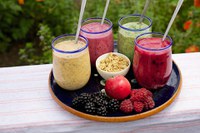Prairie Fare: Try These 7 Questions About Sun Safety
(Click an image below to view a high-resolution image that can be downloaded)
By Julie Garden-Robinson, Food and Nutrition Specialist
NDSU Extension
“Am I going to need sunglasses?” my husband asked me.
That was an unusual question.
Then I noticed he had a smirk on his face.
I was doing yardwork and feeling a bit warm in the summer sun. I had announced I was going inside our house to change into shorts. After a long, cold winter, I guess the reflection of light on my pale skin might hurt his sensitive eyes.
My husband is among the people who regularly inspire my column topics, which he did again this week. Most of the time I am giving him a bad time. He gets a turn this week.
He handed me my brimmed hat. I noted three bottles of sunscreen on the step. Using a hat and sunscreen are a couple of ways to help prevent damage to our skin and, potentially, skin cancer.
On the other hand, a little exposure to sunlight does promote the creation of vitamin D in our skin. Being exposed to sun as little as 10 to 30 minutes a few times a week provides us with adequate vitamin D, which has numerous health benefits.
Skin cancer is the most common of all cancers. Try these questions to see what you know about skin cancer:
1: Name at least three characteristics of spots (such as size, color, etc.) on your skin that should be noted to a health-care professional.
2: Which of these types of cancer is the most serious?
a: Melanoma
b: Basal cell carcinoma
c: Squamous cell carcinoma
d: Merkel cell carcinoma
3: True or False: Using a tanning bed is linked with skin cancer.
4: What is the name of the measure of the amount of UV radiation required to produce a sunburn on protected skin?
5: How much sunscreen should you apply?
a: 1 ounce
b: 2 ounces
c: 3 ounces
6: During which time period should you seek shade?
a: 8 a.m to noon
b: 10 a.m. to 4 p.m.
c: Noon to 5 p.m.
7: We should wear sunglasses that protect from UV (ultraviolet)-A and UV-B rays. Which two type of eye diseases are linked with damaging sun rays?
Answers.
1: Be sure to report to a health-care professional any spots on your skin that a) have changed in color, size or texture, b) are bigger than 1/4 inch (the diameter of a pencil eraser), c) appeared after age 21, d) appear pearly, translucent, tan, brown, black or multicolored, or e) itch, hurt, crust over or scab, erode, bleed or haven’t healed within three weeks.
2: a: Melanoma is the most dangerous type of skin cancer. It is curable if caught early.
3: True. Tanning beds are cited by the Food and Drug Administration as a known carcinogen.
4: Sun protection factor, or SPF. A higher number means that more protection is provided. Remember that exposure to sun through vehicle windows or through clothing can result in sunburns, which increase your risk for skin cancer.
Many organizations recommend an SPF of 30 or higher, especially if you enjoy being outside gardening, golfing or enjoying other outdoor activities. If you use an SPF 30 product, your skin would take 30 times longer to burn, compared with using no sunscreen. According to the Skin Cancer Foundation, an SPF of 15 is fine for occasional sun exposure such as driving to work or walking a dog.
5: a: Apply at least 1 ounce of sunscreen. If you need a visual: That’s about the amount that fits in a typical shot glass. Be sure to reapply sunscreen, especially if you swim or are perspiring on a warm day.
6: b: The sun is most damaging between the hours of 10 a.m. and 4 p.m.
7: Macular degeneration and cataracts are linked to unprotected exposure to sunlight.
As we enjoy our warmer weather, don’t forget your sunscreen, and check for an expiration date. Wear a broad-brimmed hat and high-quality sunglasses.
June is Dairy Month. Try a smoothie with dairy and fruit. Here’s a recipe and nutrition analysis from the National Dairy Council, which was created by Chicago-based chef Rick Tramonto. Slip on some sunglasses, put on sunscreen, find some shade and enjoy this recipe.
Apple Yogurt Smoothie
2 c. low-fat vanilla yogurt
1 Granny Smith apple
1/2 c. orange juice
1/2 c. ice
2 Tbsp. honey
Core, peel and dice the apple. Mix all ingredients in a blender or food processor until smooth and pour into tall glasses. Garnish with sliced almonds, fruit, julienne mint and 1/2 teaspoon of honey, if desired.
Makes two servings. Each serving has 330 calories, 3 grams (g) fat, 13 g protein, 56 g carbohydrate, 3 g fiber and 160 milligrams sodium.
(Julie Garden-Robinson, Ph.D., R.D., L.R.D., is a North Dakota State University Extension food and nutrition specialist and professor in the Department of Health, Nutrition and Exercise Sciences. Follow her on Twitter @jgardenrobinson)
NDSU Agriculture Communication - June 4, 2020
| Source: | Julie Garden-Robinson, 701-231-7187, julie.garden-robinson@ndsu.edu |
|---|---|
| Editor: | Ellen Crawford, 701-231-5391, ellen.crawford@ndsu.edu |




